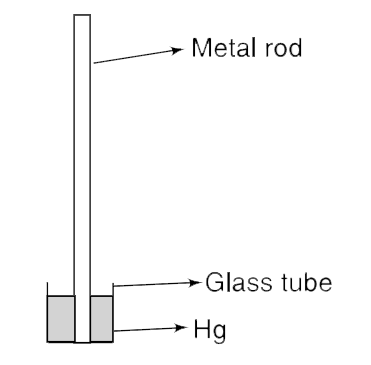A glass tube is attached to the bottom of a thin iron rod of length . To what height must the glass tube be filled with mercury so that the centre of mass of the pendulum formed will not rise or all with changes in temperature?
(Linear expansivity of glass , that of iron and cubical edxpansivity of mercury )
The correct Answer is:
Topper's Solved these Questions
Similar Questions
The scale of a barometer is made of brass and is correct is 15∘C. The reading of the barometer is 0.754m at 5∘C. Correct this reading to 0∘C. (Linear expansivity of brass =18x10−6K−1 and cubical expansivity of mercury =18×10−5K−1)
View SolutionIn design of a compensated pendulum, a light metal rod of length L0 = 1.0 m is attached to a glass tube filled with mercury. Neglecting the mass of the glass tube as well, calculate the height of mercury column in the glass tube so that centre of mass of this system does not rise or fall with temperature Given : λ)Hg)=1.82×10−4K−1,αglass')=9xx10^(-6),alpha_(mηl=1.2×10−5K−1

View Solution
Knowledge Check
The fraction of the volume of a glass flask must be filled with mercury so that the volume of the empty space may be the same at all temperature is
(αglass=9×10−6/0C,γHg=18.9×10−5/0C)A12B17C14D15A glass bulb contains air and mercury. What fraction of the bulb must be occupied by mercury if the volume of air in the bulb is to remain constant at all temperatures? The coefficient of linear expansion of glass is 9×10−6/K.
A320B32C520D12
A glass bulb contains air and mercury. What fraction of the bulb must be occupied by mercury if the volume of air in the bulb is to remain constant at all temperatures? The coefficent of linear expansion of glass is 9×10−6/K.
View SolutionA glass vessel of volume 100cm_3 is filled with mercury and is heated from 25oc to 75oc.What volume of mercury will overflow? Coefficient of linear expansion of glass=1.8×10−6c−1 and coefficient of volume expansion of mercury is 1.8×10−4C−1.
View SolutionAn iron scale is correct at 0∘C an at this temperature, a zinc rod measures 1m on this scale. What will be the length of the zinc rod as measured by the iron scale when both the are at 100∘C? (Linear expansivity of zinc =126×10−6K−1 and linear expansivity of iron =12x10−6K−1)
View SolutionA glass vessel of volume 100cm3 is filled with mercury and is heated from 25∘C→75∘C. What volume of mercury will overflow? Coefficient of linear expansion of glass =1.8×10−6/'∘C and coefficeient of volume expansion of mercury is 1.8×10−4/'∘C.
View SolutionA glass vessel of volume 100cm3 is filled with mercury and is heated from 25∘C→75∘C. What volume of mercury will overflow? Coefficient of linear expansion of glass =1.8×10−6/'∘C and coefficeient of volume expansion of mercury is 1.8×10−4/'∘C.
View SolutionA glass flask with volume 200 cm3 is filled to the brim with mercury at 20∘C. How much mercury overflows when the temperature of the system is raised to 100∘C? The coefficient of linear expansion of the glass is 0.40×10−5K−1. Cubical expansion of mercury =18×10−5K−1.
View Solution
